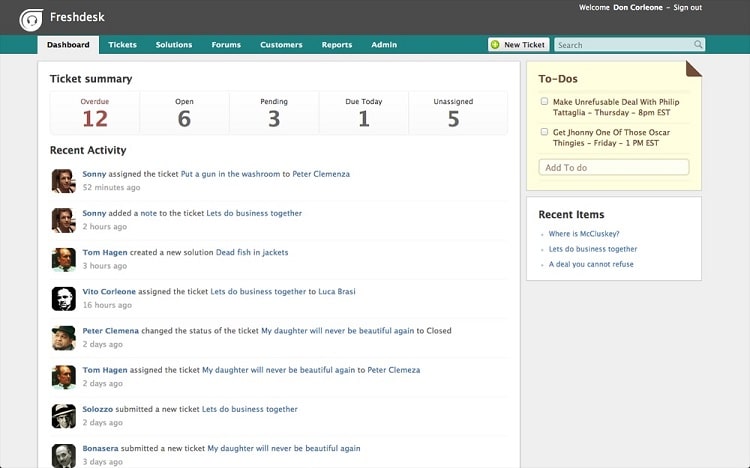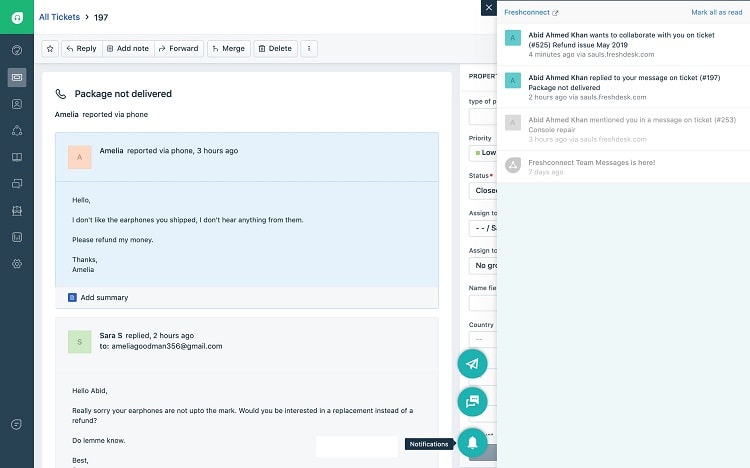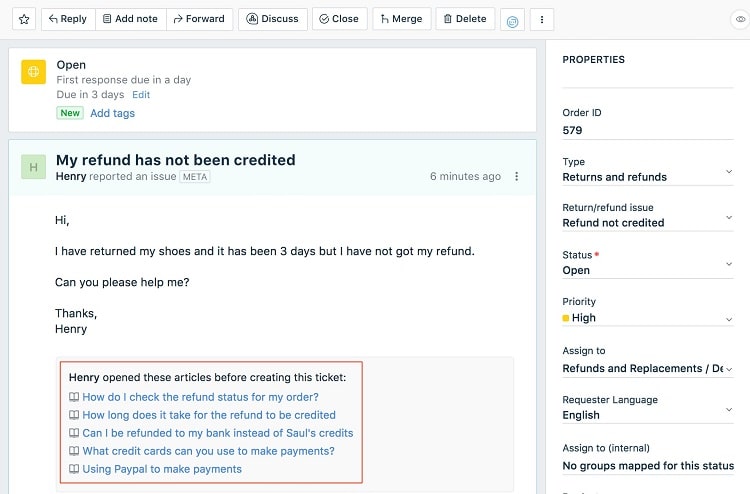If your small-to-medium-sized business is like most, your employees rely on computers and technology regularly throughout the workday. When these items are not working properly, your employees end up being less productive and more frustrated.
The majority of such businesses need to have support people available to keep the employees’ tech tools working. Depending on the needs and size of the business, it is common to have both a help desk and desktop support available. Although these are similar services, there are subtle and important differences.
The Top Rated Help Desk Software in Help Desk vs. Desktop Support
To manage the help desk requests for your SMB, deploying help desk software is a popular choice. These software packages monitor the status of service tickets, ensuring every request receives attention. They also track any service requests that must advance to the desktop support role.
- Freshdesk — Best helpdesk software for small businesses
- Zoho Desk — Best for scalability and growth
- Freshservice — Best for ITSM
- Zendesk Support — Best full-service helpdesk software
- Jira Service Desk — Best for SME Internal support
- HappyFox — Best for omnichannel ticket support
- Kayako — Best for personalized customer support
- Cayzu — Best cheap helpdesk software
You can read our full reviews of each help desk software product here.
What Is Help Desk vs. Desktop Support?
When your business is trying to determine whether you need a help desk solution or a desktop support solution, it is likely that you will need both. In fact, both of these solutions are similarly configured, meaning their services overlap quite a bit. However, they aren’t exactly the same thing.
Help desk solutions often are the first point of contact for an employee seeking help. The help desk tracks requests and solves basic problems.
Desktop support becomes part of the equation when the problems are more complex than what help desk solutions can solve. The desktop support team may provide help over the phone, may take control of the computer remotely, or may provide in-person support by putting hands on the computer.
The Basics of Help Desk vs. Desktop Support

Deciding whether you need a help-desk-only solution or a help desk and desktop support solution together can be a challenge, especially for a smaller business. However, it becomes easier when you fully understand how and when to use each type of solution.
First Contact
Generally, the help desk team will handle the first contact with an end user who is having an issue.
This initial contact may occur through help desk software. In this scenario, the end user would report and explain the problem through email or through a software interface. The software then would use this information to generate a support ticket automatically.
Some help desk teams prefer to receive a phone call when an end user is reporting a problem. The help desk team can still make use of help desk software in this scenario. The help desk team member would fill out the support ticket, rather than having the end user complete the ticket.
When dealing with end users over the telephone, it is important for help desk team members to have strong communication skills. End users who are having computer problems likely will be experiencing agitation. Team members need to be able to speak calmly and provide answers that de-escalate the situation.
Problem Solving
After the help desk software creates the support ticket, members of the help desk team can begin trying to solve the problem. The help desk software should track the steps the help desk team members take to try to solve the problem.
If the end-user generated a request for support via a ticket through the software, the support team member would then reach out to the end user, usually via a phone call or a chat session. Otherwise, if the help desk team takes the call from the end user to report the problem, the team member can begin troubleshooting the problem immediately.
For initial problem-solving skills, it is important for the help desk team members to ask the right questions. After listening to the end user’s description of the problem, the support team member can use that information to begin asking related questions and making troubleshooting suggestions.
As the support team member attempts different troubleshooting techniques, it’s important to enter these attempts into the support ticket. You will want a clear list of steps the help desk support team took to try to solve the problem. This information is helpful if the problem reoccurs later or if the desktop support team needs to take over the case.
Moving to Desktop Support
Sometimes, the help desk team simply cannot create a workable solution to the end user’s problem. If your business has a desktop support team, the help desk can advance the problem over to desktop support.
When a business has separate help desk and desktop support teams, the desktop support team members would have a higher level of training. This training allows these team members to solve more complex problems or perform hands-on troubleshooting techniques.
For a smaller business that only has help desk solutions, you may want to have one person who takes over during complex issues. This person may have a bit more training to provide a higher level of support than what the help desk support team member typically can do.
How Desktop Support Works
In addition to providing help for complex computing and tech problems, desktop support may communicate with the end user in a few different ways.
- Telephone: The desktop support team may start with a telephone consultation with the end user. The telephone call can help the desktop support team gain more information. The team may try a few different basic troubleshooting techniques versus what the help desk tried.
- Remote access: If the problem continues, desktop support may choose to set up a remote access session to try to solve the problem. In this situation, desktop support will take over the operation of the end user’s computer via an internet or local network connection.
- Hands-on work: In certain circumstances, the desktop support team member will travel to the end user’s location to work on the computer in person. This is not always possible, such as if your business has a remote workforce, but it can be one of the surest ways to troubleshoot a problem.
No matter what kinds of steps the desktop support team takes on behalf of the end user, it should document those steps in the help desk software. Support tickets need to be as accurate and detailed as possible, so the support team can spot trends that could indicate a problem like a virus infection on the network.
5 Tools to Improve Help Desk vs. Desktop Support

Many times, your business can greatly improve its level of tech support through the use of help desk software tools. These tools can automate some processes, such as tracking support tickets and offering self-help options. This gives the support team more time to deal with complex issues.
Freshdesk
Small businesses that don’t have a large number of resources they can dedicate to support will appreciate Freshdesk. This help desk software simplifies the process of handling support requests, preserving time that the team then can spend on solving problems.
Freshdesk works to enhance communication among your support team members as well, which allows them to bounce ideas off each other. Multiple pricing tiers are available, including a free tier you can use to test how the software’s features match your needs.
Zoho Desk
If your business needs to be able to provide help desk support and desktop support in a variety of ways, Zoho Desk is well worth considering.
It has a strong mobile app, which allows your support team to deliver help from anywhere for end users. Zoho Desk has multiple pricing tiers, so you can add more complex features as your business grows. Additionally, it can handle the support needs of almost any size of business.
Freshservice
If you feel like your help desk team and desktop support team could use better problem-solving tools and a higher level of modernization, Freshservice is a strong choice. It provides automation to solve basic processes for end users, freeing up your team to handle more complex situations.
Freshservice comes from the same manufacturer as Freshdesk. Versus Freshdesk, Freshservice works better for IT service management (ITSM) and for larger businesses that have complex support team requirements.
Zendesk Support
When you need help desk software that can handle a wide range of situations, Zendesk Support is a powerful, full-service option. It will yield favorable results for both small and large support teams while handling support requests ranging from simple to complex.
Should your team need a customized support ticket creation process, Zendesk Support is a good choice. It allows your team to use the standard, pre-built ticketing process it offers, or you can add some items to the ticket that are unique to your business.
Jira Service Desk
Although Jira Service Desk is a strong help desk software option, it can deliver other types of support needs as well. If your employees need to report a broken light or torn carpeting in the building, Jira Service Desk can aid with delivering these issues to the correct department.
However, its primary strength lies in allowing your help desk team and desktop support team to efficiently serve your end users’ computing and tech needs. This software works well for large enterprises, as it can support up to 5,000 customer support agents.
3 Tricks for Help Desk vs. Desktop Support

Simply having help desk and desktop support service available for your employees and for your business’s clients isn’t enough. Our tips and tricks can help you make your solutions more efficient, giving employees and clients a level of service they can trust.
Managing Assets
As a smaller business, you may not be able to deploy a large IT department. This means keeping track of the business’ hardware – both hardware in use and in storage – likely falls to the desktop support team.
When your business doesn’t track and manage its hardware tech assets successfully, it can cause waste. If you don’t know exactly which computers are out in the field with employees, you could be susceptible to theft or loss. If an employee loses a laptop and the desktop support team doesn’t know about it, a hacker could use it to gain access to the network.
When new employees come on board or when equipment needs replacing, knowing what you have in storage ensures your business doesn’t needlessly spend money. You won’t buy tech hardware that you already own and can deploy.
If your tech support team is already at its maximum workload with time spent helping end users, things like asset management fall by the wayside. It is possible that the desktop support team will need more personnel or a greater level of resources devoted to it to deliver the desired results.
Being Proactive
Help desk and desktop support solutions frequently involve reacting to the problems that others are having. However, your team can be even more efficient when taking some steps to try to be proactive.
For example, a help desk team may deploy self-help documents or automated support processes. End users having basic problems then may be able to solve the problems themselves, freeing up time for the support team to deal with more complex problems.
For the desktop support team, proactive measures can include things like:
- Staying up to date on installing software updates
- Performing occasional hardware audits to ensure the list of assets is accurate
- Scheduling outages at times when they will cause the least disruption
- Maintaining backup copies of all data
- Testing security measures for the business’ network
Developing Protocols
Your help desk and desktop support teams will work together better when you have protocols that determine when support requests should move forward.
As a starting point, the help desk team should have steps in place to ensure the support ticket is accurate and informative. Rather than allowing help desk team members to place random information on a ticket, every ticket should have specific information on it, including:
- Name of the support person
- Time and date of the call
- Reported problem from the end user
- Steps taken to try to fix the problem
- Any need for a follow-up call
- Whether the issue needs to move to the desktop support team
Having detailed notes will help if the same end user reports the same problem in the future. If the issue ends up needing to move to desktop support because of its complexity, the desktop support team can use the history as a starting point.
Additionally, the protocols for your support teams should provide clear guidance as to when a help desk team member should move the process to desktop support.
What to Do Next?
As you are trying to determine whether you need help desk solutions, desktop support solutions, or both, always remember that both of these are a form of customer support. In fact, you may need to use your help desk software as customer support, helping a client make use of your systems. It’s important for these systems and for your personnel to run as smoothly as possible when they are interacting with customers.
Although your level of tech support for employees and clients may not rise to the level of a tech support business, you may want to treat it like one. Employees who receive help quickly from a competent support team will be more efficient as they work. If clients don’t feel like they can trust your support team, they likely won’t trust your business very long either. Having strong help desk and desktop support solutions will be vital to your business’ success.
from Quick Sprout https://ift.tt/Yx01aSw
via IFTTT
No comments:
Post a Comment